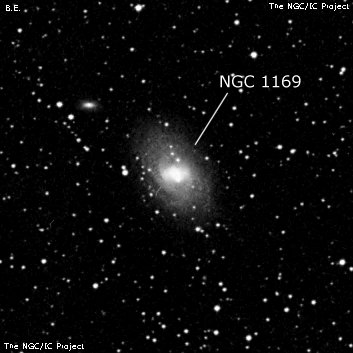
William Herschel discovered NGC 1169 = H II-620 = h279 on 11 Dec 1786 (sweep 645) and logged "F, S, irr R, bM." His position is at the northeast end of the galaxy. Interestingly, John Herschel reported on 31 Dec 1831 (sweep 390), "vF; irreg figure. Suspected to be only a few stars." R.J. Mitchell, Lord Rosse's observer on 11 Dec 1854, recorded a "B* sp the Nucl and a vF* ? involved np the Nucl. The neby fades away gradually." The RNGC places this galaxy 1.0 min of RA too far east.
200/250mm - 8" (1/1/84): faint, very small, slightly elongated. Only the core was visible as I missed the large halo.
400/500mm - 17.5" (10/24/87): moderately bright, very small, bright core. With averted vision a large extremely faint halo is visible elongated SW-NE. A mag 13.5 star is superimposed at the SW side of the core! NGC 1169 is located just 10.6? from the galactic equator. It's is a huge spiral, with a diameter of 170,000 light-years.
600/800mm - 24" (2/8/18): at 200x; bright, very large, oval 4:3 SW-NE, ~2.5'x2.0', sharply concentrated with a very small bright core/nucleus. A bright star (mag ~13) is superimposed at the SSW edge of the nucleus! Located in a Perseus star field rich in fainter stars.
LEDA 2280846 is just 3' NE of center. At 375x it appeared very faint (mag 16.2B), small, oval 3:2 E-W, 15"x10", fairly low even surface brightness. It forms the western vertex of a small triangle with two 13th mag stars 0.6' SE and 0.8' E.
Notes by Steve Gottlieb